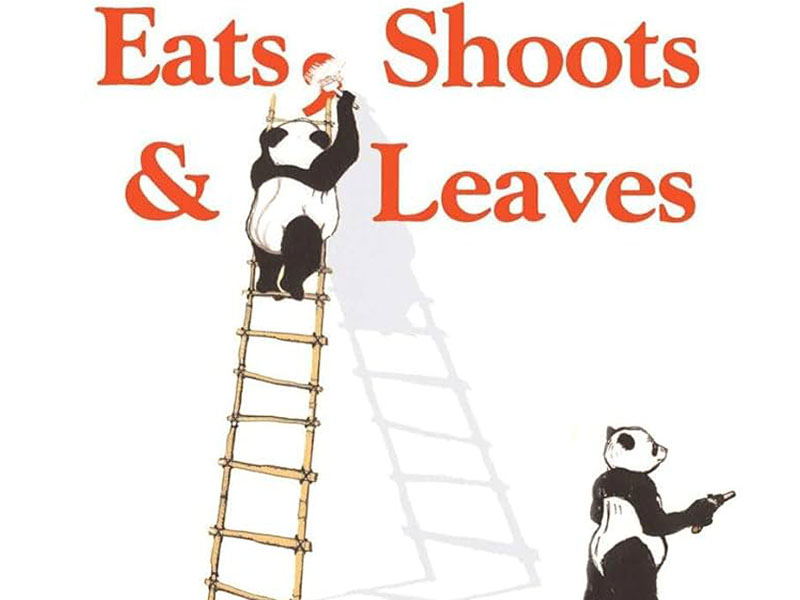
12 Aug (Who) Eats Shoots and Leaves?
(Who) Eats Shoots and Leaves?
by Leslie Battis
 In a foray through the Library’s non-fiction collection, I made some interesting finds. The 400s (language) includes books about English grammar and style, which I appreciate as an editor. A particular favorite is Eats, Shoots & Leaves: The Zero Tolerance Approach to Punctuation. The title of the book shows how important a comma can be. There’s an old joke about bad punctuation. Who eats shoots and leaves? A panda, of course. But insert a comma after “Eats”, and that panda eats a sandwich in a cafe, shoots a gun in the air and leaves.
In a foray through the Library’s non-fiction collection, I made some interesting finds. The 400s (language) includes books about English grammar and style, which I appreciate as an editor. A particular favorite is Eats, Shoots & Leaves: The Zero Tolerance Approach to Punctuation. The title of the book shows how important a comma can be. There’s an old joke about bad punctuation. Who eats shoots and leaves? A panda, of course. But insert a comma after “Eats”, and that panda eats a sandwich in a cafe, shoots a gun in the air and leaves.
If instruction in proper grammar doesn’t entice you, how about learning a new language? In addition to the usual French, Italian, and Spanish books, we have Latin, Gaelic, Afrikaans, and Egyptian Hieroglyphics.
The 800s (literature) had some of the oldest books in the circulating collection. As I was inventorying these books, I found a copy of Helen Keller’s The Song of the Stone Wall (1910). This poem is about a stone wall in New England that has witnessed the history of the nation. I like the imagery of Keller reading the stone wall as she would a book – with her hands. This book is now in our Rare Book Room.
The oldest book I’ve found so far was in Biographies. The Mountain Wild Flower by Charles Lester (1838) is a biography of Mary Ann Bise who lived near the Green River in New York state, just northwest of Great Barrington, and died at the age of twenty-three. Listed in the first catalogue of the Norfolk Library (1907), the book has been in our stacks for over 100 years. But it has not been forgotten. Right after I found it, we received an inter-library loan request for the book. Because of its age, we chose not to circulate it.
Perusing biographies, I was at first shocked to find a copy of Mein Kampf by Adolf Hitler. Mein Kampf is one of the most disputed books in history and there it was, on our shelf. I wondered why we would have a copy of such a hateful book. The answer to my questions was on the inside cover. Our early translation of Mein Kampf was published so that people could know what Hitler was like. The editors wrote that Mein Kampf “is probably the best written evidence of the character, the mind, and the spirit of Adolf Hitler and his government.”
We have the Reynal & Hitchcock translation published in 1939 by Harcourt, Brace with a license from Houghton Mifflin. Our book is from the first US printing. This copy has many annotations that explain German history to an American reader and that refute the racist theories in Hitler’s book. The editors wrote that “truth, the accurate truth, is the only argument which in the long run prevails.”
Hitler never received royalties from the sale of the Reynal & Hitchcock translation. In 1939, citing the Trading with the Enemy Act, the American government seized all profits and rights to Mein Kampf in the US. Royalties were paid into the War Claims Fund, which benefited American POWs and displaced Jews.
In 1979, Houghton Mifflin bought back the rights from the US government. A report in 2000 publicized that the company had made hundreds of thousands of dollars from sales of Mein Kampf. Houghton Mifflin responded by donating subsequent royalties to Jewish charities (most of which did not want the money). Houghton Mifflin now donates royalties to Holocaust education and a fund for aging Holocaust survivors.




Sorry, the comment form is closed at this time.